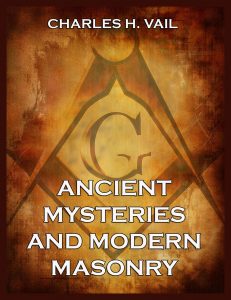Ancient Mysteries And Modern Masonry – Charles H. Vail
The purpose of these lectures is to consider the origin and nature of the Ancient Mysteries and Modern Masonry and to show the relation which they bear one to the other. Freemasonry deals largely with the morals and symbols of the Mysteries of Antiquity, and originally was one of the channels of Ancient Wisdom. There were a few among the founders of Modern Masonry who possessed the Royal Secret, or, at least, had a knowledge of its existence, and, if the key has been lost, the Mason, as Heir-apparent of the Old Wisdom, should be foremost in the search for its recovery. All agree that the Masonic symbols and traditions are of the greatest antiquity, and can be traced to the far East–to the earliest civilization, from which time and place they have spoken in nature’s language to all peoples of the earth. We are more and more convinced that this picture language of our ritual contains a most complete philosophy–a knowledge embracing the eternal verities of the universe, and that these symbols were designed by the Initiates of old to preserve and convey that Ancient Wisdom to the present and future generations. Though empires and dynastic continents have appeared and passed away, these ancient symbols, hewn in rock-cut temples and monuments, have served to convey the Great Secret from ages past and will continue its record as long as this part of the universe remains.

Ancient Mysteries And Modern Masonry
Format: Paperback.
Ancient Mysteries And Modern Masonry.
ISBN: 9783849675844.
Available at amazon.com and other venues.
Basics of Freemasonry (from wikipedia.com)
Freemasonry or Masonry consists of fraternal organisations that trace their origins to the local fraternities of stonemasons, which from the end of the fourteenth century regulated the qualifications of stonemasons and their interaction with authorities and clients. The degrees of freemasonry retain the three grades of medieval craft guilds, those of Apprentice, Journeyman or fellow (now called Fellowcraft), and Master Mason. These are the degrees offered by Craft (or Blue Lodge) Freemasonry. Members of these organisations are known as Freemasons or Masons. There are additional degrees, which vary with locality and jurisdiction, and are usually administered by different bodies than the craft degrees.
The basic, local organisational unit of Freemasonry is the Lodge. The Lodges are usually supervised and governed at the regional level (usually coterminous with either a state, province, or national border) by a Grand Lodge or Grand Orient. There is no international, worldwide Grand Lodge that supervises all of Freemasonry; each Grand Lodge is independent, and they do not necessarily recognise each other as being legitimate.
Modern Freemasonry broadly consists of two main recognition groups. Regular Freemasonry insists that a volume of scripture is open in a working lodge, that every member profess belief in a Supreme Being, that no women are admitted, and that the discussion of religion and politics is banned. Continental Freemasonry is now the general term for the “liberal” jurisdictions who have removed some, or all, of these restrictions.
(The text of the last section was taken from a Wikipedia entry and is available under the the Creative Commons Attribution-ShareAlike License.)
Publisher’s Note: This book is printed and distributed by Createspace a DBA of On-Demand Publishing LLC and is typically not available anywhere else than in stores owned and operated by Amazon or Createspace.
